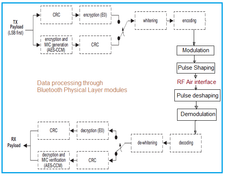DDS (Direct Digital Synthesizer) Basics
Advertisement
This page covers DDS (Direct Digital Synthesizer) basics and provides a link to an RF synthesizer design example using a DDS Chip. RF Synthesizers have been used for years in wireless communication systems as tunable sources. This helps in RF channel selection in a variety of applications such as TV, radio, and satellite. It is also widely used in test and measurement equipment such as synthesizable sweepers, RF vector signal generators (VSGs), and RF vector signal analyzers (VSAs), etc.
DDS is a technique that generates frequency/phase tunable output signals based on a fixed frequency clock reference. The full form of DDS is Direct Digital Synthesizer. It is also referred to as Direct Digital Synthesis.

There are many benefits (advantages) of the DDS technique as mentioned below:
- Step sizes in micro-Hz can be achieved.
- Fast hopping speed.
- Avoids tuning needed in analog counterparts due to component aging as well as temperature drift.
- As the DDS chip provides digital control, it can be remotely controlled using a microcontroller/microprocessor/DSP/FPGA.
Figure-1 depicts a simple DDS Block Diagram. As shown, it consists of a clock reference, address counter, PROM, and DAC. In DDS, digital information of amplitudes of the entire 360-degree cycle information of the sinewave is stored in the PROM (Sine lookup table). This amplitude information is provided at the input of the DAC (Digital to Analog converter) at each clock. This is achieved with the help of the address counter which provides address information to read the stored data from the register. Hence, the DAC generates an analog sinewave based on digital input words stored in the PROM.

The figure-2 depicts the internal functional modules of the DDS chip. As shown it consists of a phase accumulator and a phase-to-amplitude converter. The binary tuning word (N) is provided as input to the phase accumulator. The phase register generates binary phase information in a few number of bits. The tuning word specifies the output frequency as a function of the reference clock frequency.
The following formula/equation is used to determine the output frequency of a DDS chip. Using this equation, M is determined based on FOUT, Fref and N.
FOUT = M * Fref / 2N
where:
- FOUT = The output frequency of DDS
- M = Binary tuning word (32 bits binary information)
- Fref = Reference clock frequency
- N = Length in bits of the phase accumulator (example: 32) (Determines frequency resolution)
Advertisement
 RF
RF





